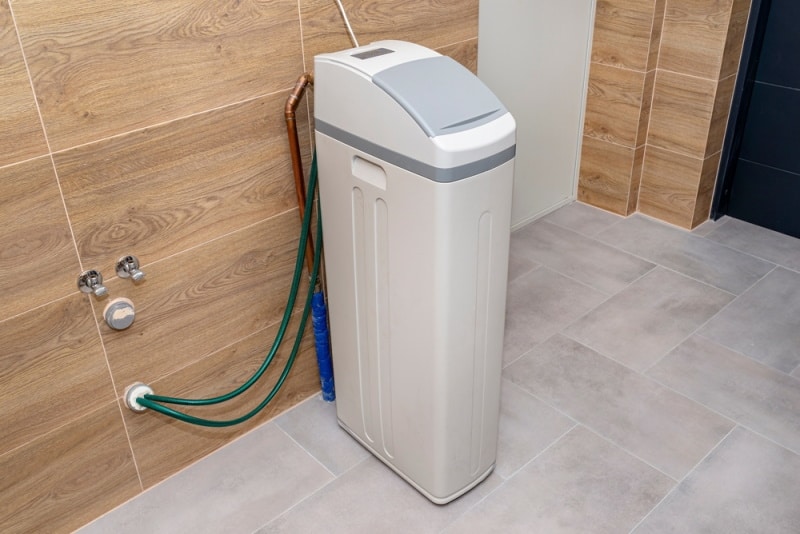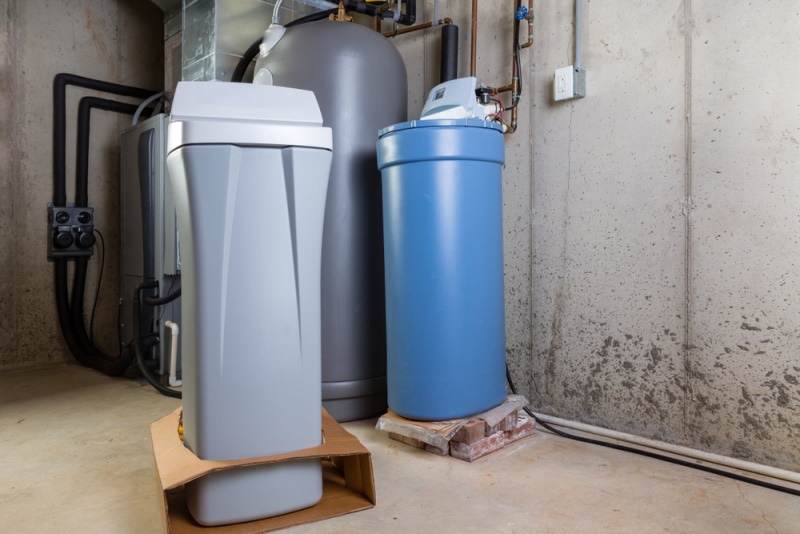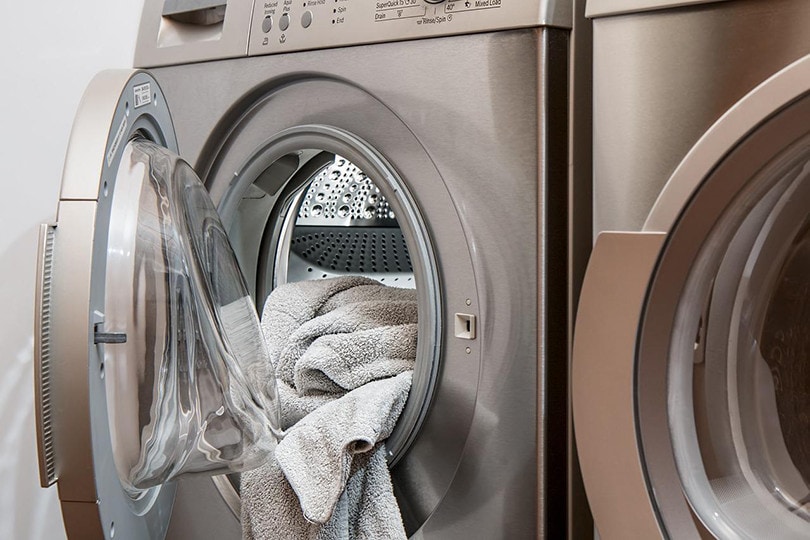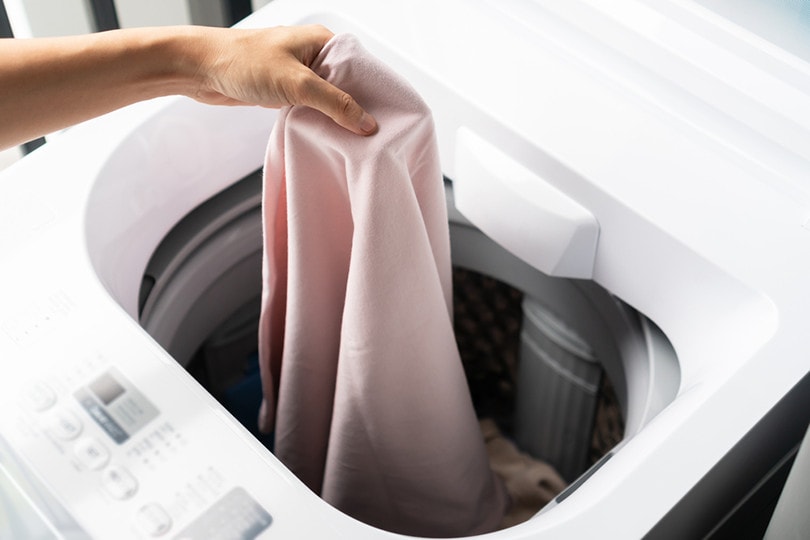How Does a Water Softener Work? Parts & Processes Explained
-
Pete Ortiz
- Last updated:

A water softener is not a chemical substance, but a system. We often like to describe it as a whole-house filtration system, specifically designed to get rid of magnesium and calcium ions from water. That process is called ion exchange, and the minerals being removed are the elements responsible for water hardness.
Even though there are no known health risks associated with hard water 1, the fact that it normally wreaks havoc on our properties means we still have to find ways of treating it. If you keep on using hard water in your home liberally, your pipes will eventually clog due to scale build-ups, and the kitchen appliances’ lifespan will drastically reduce.
You’ll be glad to hear that the principle behind this process is not as complex as you may think.
How Does It Work?
Water softeners were designed to function the same way magnets do. All traditional magnets usually have ends that are oppositely charged—one’s positive, while the other is negative. If you try to connect two positive ends, they’ll repel each other. But if you push that same positive pole towards the negative, they immediately connect.
That’s how softeners operate. We already know that calcium and magnesium are the main culprits responsible for turning soft water into hard water. Both elements have positively charged molecules, so all we have to do is to find them some negative charges.
That’s where our water softener system comes in. This system is made up of different components, one being the mineral tank. Your hard water will enter that tank and then flow through resin beads, which are produced using polystyrene. It’s at that point where the ion exchange takes place.

Since the beads are acting as anions (negatively charged), they’ll seek out cations (positively charged molecules) in their immediate vicinity, so that they can bond and form stable compounds. Calcium and magnesium will be the only positively charged ions around so the charged resin bead molecules will have no other choice but to grab both of them.
Because it’s an ion exchange process, to restore the water’s original stable condition, the beads will offer sodium ions. Sodium does not contribute to the water hardness in any way.
Components Of the Water Softener System
A conventional softener will have three main components: the brine tank, mineral tank, and control valve. While working in tandem, they’ll clean the system, record the volume of water flowing, and eliminate all water-hardening minerals.
Mineral Tank
This is where all the magic happens. Your water supply line feeds this tank with a sufficient amount of water, which is meant to seep through the beads that have been laid out at the bottom. When you see water exiting from the other end, it will be devoid of all water-hardening ions.
Control Valve
The control valve has a meter tasked with tracking the amount of water being fed into the tank, and that which is flowing into our homes. We have to track that water volume because the whole ion exchange process normally depletes the resin bead’s capacity to effectively soften water. When the valve senses that the beads are about to become overburdened, it quickly initiates a regeneration cycle.
And yes, the whole thing is automated, courtesy of the valve’s onboard computer. The resin beads’ maximum capacity will already be pre-programmed into the system, after taking into consideration factors such as level of water hardness, size of household, property size, etc.
Brine Tank
In terms of size, this tank is relatively smaller than the mineral tank. It’s designed to help in regeneration, and that’s why it stores concentrated solutions of salt. If you’re the system’s user, you’re supposed to manually add blocks or pellets of salt in the tank every so often. Because when that valve registers a diminishing resin bead capacity, it will trigger the release of the brine tank solution without any warning.

What Are the Different Types of Water Softeners?
Understanding the key features of the different types of softeners is important, as that knowledge will help you choose what’s best suited for your home. Just like any other product, they all have pros and cons. So, it’s a question of what you’re willing to compromise and what you’re not.
These are the six softeners available on the market:
Salt-Based Water Softeners
This is the original water softener system and the one that we’ve just talked about. Some people like to call it the ion-exchange softener, as it often releases sodium ions while absorbing the heavy water-hardening metals. The salt-based water softener is durable and budget-friendly. But most users loathe the fact that they have to manually add salt occasionally.
Salt-Free Water Softeners
Instead of utilizing salt, this softener uses a Template-Assisted Crystallization System to remove all those calcium and/or magnesium minerals. So, if the idea of manually adding salt to your system doesn’t sound too appealing, you could go for this improved version. But you also have to understand that it won’t be as effective as the salt-based softener if you’re looking to treat very hard water.
Dual-Tank Water Softeners
The sole difference between this model and your traditional water softener system is that this variant has two tanks. Meaning, you’ll be able to soften large volumes of water in a short time period. This is the most recommended system for households that often register high water usage.

Magnetic Water Softeners
These softeners are designed to use their magnetic fields to strip away the positive and negative ions that constitute the water-hardening minerals. The affected minerals will still be present in the water in their soluble form, but not bonded to each other.
We’ve heard some users complain about how they found these systems to be ineffective, especially when treating large volumes of water. So just keep that in mind the next time you go out shopping.
Reverse Osmosis Water Softener
This model usually produces high pressure, which is meant to push water through a semipermeable membrane to filter out all the nitrates, heavy metals, and water-hardening minerals. We would never recommend this system to anyone, as it uses more water than it releases. Also, it’s not designed to treat the whole house’s water system.
Shower-Head Water Softeners
As the name suggests, they are supposed to eliminate minerals from the running water that’s seeping through your shower head. These softeners are meant to protect your skin and hair while you’re bathing, as the minerals can cause them to dry out. We found them to be durable and easy to install, but come with filters that have to be replaced from time to time.

Where Are Water Softeners Used?
Water softener systems are normally installed in homes to protect pipes against mineral build-up and appliances like the dishwasher that are designed to use soft water. However, that doesn’t mean that you won’t find one of these systems in a commercial facility, like the gym. If the only accessible water is the hard one, they’ll install one to make it easier for their clients to lather up while showering.
What Are the Advantages of Water Softening Systems?
No Hard Water Stains
Once you’ve installed this system, you won’t have to worry about dealing with soap scum marks (or watermarks of any kind) on your sink surface and around the taps.
Unclogged pipes
If your pipes are clogged, and you have a fully functional water softener already installed, it’s due to a different reason. A scale buildup cannot be the cause of the damage unless you forgot to add salt to your brine tank. The system will be operating at a limited capacity if the sodium supplied is insufficient.
Residue-free appliances
It’s a known fact that hard water shortens the lifespan of several kitchen appliances, such as the water purifier. During the filtration process, the scales usually affect the reverse osmosis membrane, consequently lowering the quality of the water being released.
Softer Clothes
First off, you’ll be forced to use lots of detergents when washing clothes using hard water, since they don’t efficiently dissolve as they do in soft water. The minerals also make dissolving fabric softeners difficult. And after drying out the clothes, they’ll appear dingy and faded, thanks to the mineral deposits left behind.

Smoother Skin & Hair
The skin is the largest organ of the body. It has hair and produces its own oil. Showering using hard water is not advisable as it will deplete your skin’s natural oil. Eventually, you’ll start experiencing skin flare-ups, and your hair will always feel frizzy and brittle.
What Are the Disadvantages of Using Water Softening Systems?
Softened Water Isn’t Safe for Drinking
According to the Center for Disease Control and Prevention (CDC), an increased sodium intake could lead to stroke, heart attacks, and high blood pressure. Water softened using salt-based systems normally has elevated sodium levels, meaning it’s not entirely safe for consumption. Before drinking any of it, you’ll have to eliminate the sodium using the reverse osmosis method, or through distillation.
Environmental Impact of Sodium
At low concentrations, sodium is harmless. But if everybody starts using these systems, the amount of sodium being released as waste can be fatal to aquatic plants and animals. All living organisms contribute something different to our ecosystems and thus have to be protected. If our ecosystems are in disarray, we won’t be able to access safe food or breathe clean air.
Frequently Asked Questions (FAQs)
What Are the Signs You Need to Install a Water Softener System?
If you’ve noticed some of your clothes are stiff or hard, there are detergent curds in your bathtubs, sinks, or washing machines, and you’re really struggling to lather up while showering, you’ve definitely been using hard water.
Don’t wait for the municipality to treat it because their job is to ensure that you’re getting safe water, and hard water is technically harmless. Install a softener and then a distiller, if you’ll be drinking that same water.

Do Water Softeners Systems Add Value to a Rental Space or Home?
Real estate investors are normally wary of buying homes located in hard water areas, because most of the time, the plumbing system is just a hot mess. But if you’ve already installed a water softening system, chances of your house selling at top dollar are already high.
Do People Drink Hard Water?
In healthy doses, the two common water-hardening minerals are very important to our bodies. In addition to supporting our nerve and muscle functions, they also help to reduce the probability of developing cardiovascular conditions. Drinking softened water is what you should be more worried about if you’re predisposed to high blood pressure.
Conclusion
Before buying a water softening system, test your water. You must first find out what kind of minerals are making it hard so that you can get a system that’s not only efficient but also effective. Also, don’t drink any water treated using a salt-based system if you care about your health.
Featured Image Credit; Kinek00, Shutterstock
Contents




